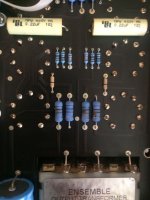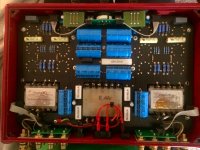At first my left channel sounded quiet, then a tube began to glow and shudder, sending a buzz to the speakers. I jumped from the couch and raced to turn my amp off, but not before a pop a hiss and a sidewinder of smoke up into the ether.
****.
Here's a picture of the undercarriage. There's oil dropping from the transformer and I can see some burn marks on the resistors near the tube that acted a goof.
So, what to do? Anyone have a high-level diagnosis? Can a guy with soldering iron and some online help fix this? Is there a great fix-it guy in LA or So-Cal?
Any and all help appreciated.
****.
Here's a picture of the undercarriage. There's oil dropping from the transformer and I can see some burn marks on the resistors near the tube that acted a goof.
So, what to do? Anyone have a high-level diagnosis? Can a guy with soldering iron and some online help fix this? Is there a great fix-it guy in LA or So-Cal?
Any and all help appreciated.
Attachments
I do have a multimeter. I've used it to troubleshoot circuits on a motorcycle, but nothing quite like this.
Is the oil leaking from the transformer not an issue?
Is there a better board to get help with this? I know you guys like to build from scratch.
also, I don't know if this helps, but I replaced the tube, turned it on and it still works well.
Is the oil leaking from the transformer not an issue?
Is there a better board to get help with this? I know you guys like to build from scratch.
also, I don't know if this helps, but I replaced the tube, turned it on and it still works well.
also, I don't know if this helps, but I replaced the tube, turned it on and it still works well.
in Synthesis this kind of problem is normal !!this is not expensive amp . all out put tubes should be replace.
Is the transformer goo solid or liquid? Those MOX G2 resistors look toasted!
It's liquid. Like motor oil
That's pretty alarming. I might be looking to pull the covers and see how things look on the inside.
I would get some rubber gloves, paper towels, alcohol, and a trash bag to clean that oily substance off. Chinese mystery transformer oil doesn't sound like a substance you want to touch!
I would get some rubber gloves, paper towels, alcohol, and a trash bag to clean that oily substance off. Chinese mystery transformer oil doesn't sound like a substance you want to touch!
When you replace the burned resistors, take some higher wattage ones and replace all eight of them. Some of the others look a bit discoloured as well.
The big cement 180R resistors are most likely for each cathode.
With the power off and the high voltage caps drained (leave the amp disconnected from the mains for enough time and verify that they are discharged!), measure the resistance to ground. It should be the same for all.
The different discolouration of the blue resistors suggest that the output valves were not balanced (different dc current). Cathode biased, so that means the valves were badly matched or some were worn out.
If you want to take measurements after replacing the burned resistors, start with the dc voltage on those 180R resistors. This should tell you how much current goes through each output valve.
Very important: know what you're doing! Read about electrical safety!
Valve amps can bite. Accidentally touching a high voltage point will leave you with a painful memory at best. At worst.... Well, keep posting so we know you're ok
The big cement 180R resistors are most likely for each cathode.
With the power off and the high voltage caps drained (leave the amp disconnected from the mains for enough time and verify that they are discharged!), measure the resistance to ground. It should be the same for all.
The different discolouration of the blue resistors suggest that the output valves were not balanced (different dc current). Cathode biased, so that means the valves were badly matched or some were worn out.
If you want to take measurements after replacing the burned resistors, start with the dc voltage on those 180R resistors. This should tell you how much current goes through each output valve.
Very important: know what you're doing! Read about electrical safety!
Valve amps can bite. Accidentally touching a high voltage point will leave you with a painful memory at best. At worst.... Well, keep posting so we know you're ok
Oops.
So wouldnt it be better just to replace the transformer?
no .....transformer is expensive.no need to replace .your amp story was simple .
just tube and than resistor should change by new one .
no .....transformer is expensive.no need to replace .your amp story was simple .
just tube and than resistor should change by new one .
Just to confirm, even though the transformer has leaked oil, there is no need to replace it?
This is good news, so I'm not being argumentative. Just making sure.
- Status
- This old topic is closed. If you want to reopen this topic, contact a moderator using the "Report Post" button.
- Home
- Amplifiers
- Tubes / Valves
- Troubleshooting Synthesis Ensemble 30W amp

